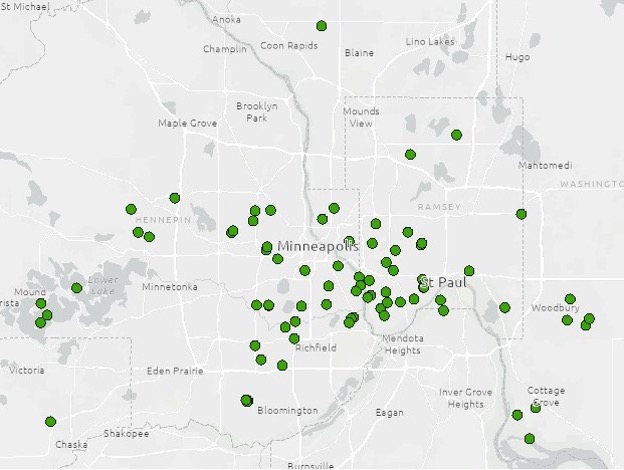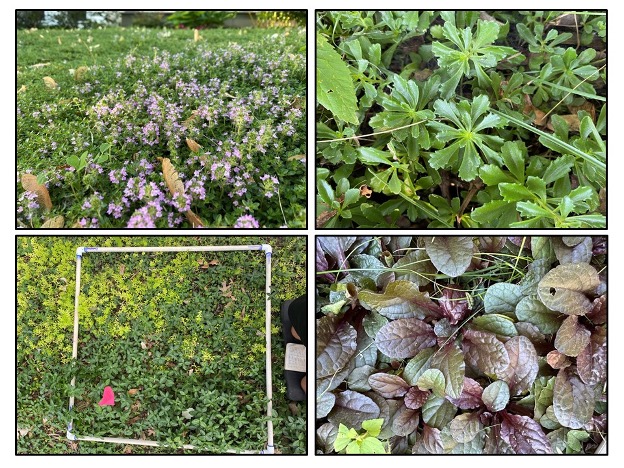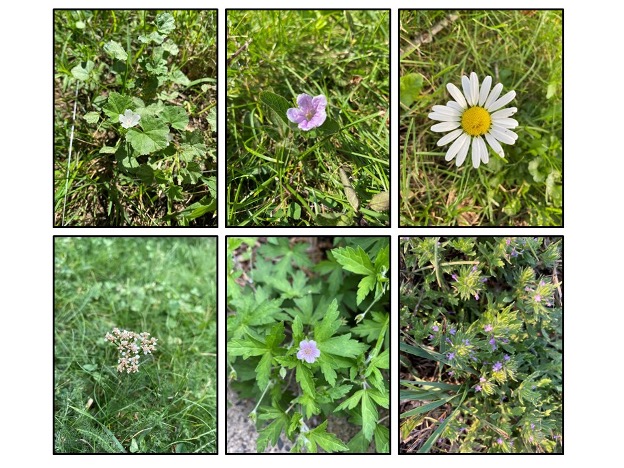By Ryan Schwab and Jillian Turbeville
Long-Term Ecological Research (LTER) sites, funded by the National Science Foundation, are focused on learning about various ecosystems such as bogs, prairies, and arctic landscapes. A complex ecosystem that impacts many of us directly is urban areas. The Twin Cities Metropolitan Area (TCMA) was chosen as a site (MSP LTER) to understand a holistic view of urban nature. Since Fall 2021, our group has been tasked with annually determining plant species on 80 TCMA lawns (Figure 1). Of these properties, 31 were self-reported bee lawns. Bee lawns differ from traditional turfgrass lawns in that they are enhanced with low-growing flowering species that provide forage for bees and other insect species. Any combination of fine fescues (Festuca spp.), white clover (Trifolium repens), self-heal (Prunella vulgaris), and/or creeping thyme (Thymus spp.) are common in bee lawns. In addition to the plant species composition data, a pollinator research group is teamed up with us to determine pollinator insect abundance and richness. This will allow us to observe possible relationships between pollinators found in different lawn types or plant species within the lawn.

Bee lawns are becoming a more popular and community-accepted choice for homeowners and are supported at different levels of the green industry. The state of Minnesota assists the conversion of residential lawns to pollinator-friendly yards by offering the Lawns to Legumes grant program for individuals. This program has an abundance of resources and provides up to $350 for conversion supplies and seed. Local seed companies also recognize the movement by making bee lawn species more available, and some also have specific bee lawn mixtures. Due to the demand for lawn conversions, a handful of lawn care companies provide bee lawn establishment services. These efforts have increased access to bee lawn conversions and resources for homeowners. See our Bee Lawn Seed webpage for information on bee lawn companies.

During our lawn assessments, we were able to visit with a number of homeowners, and we learned the establishment of bee lawns was accomplished through a few paths. Some homeowners utilized a lawn care company to renovate their properties. Others purchased seed and installed a bee lawn themselves from scratch. Overseeding flowering species in an existing lawn was one of the more common methods of bee lawn enhancement. Instead of seed, some directly planted plugs of alternative groundcovers, including creeping thyme, sedums (Sedum spp.), vincas (Vinca spp.), and bugleweed (Ajuga reptans), to proliferate in certain areas (Figure 2). A handful of properties already had flowering species, such as white clover, dandelions (Taraxacum officinale), geraniums (Geranium spp.), and wild violet (Viola spp.), which were encouraged to grow and spread. Our team observed many flowering plant species in lawns, many of which may be perceived as weeds or invasive plants by some (Figure 3).

This inventory of lawn species in the TCMA will help researchers in the LTER answer several questions:
- Which plants encourage the presence of pollinators in lawns?
- Do lawn care practices such as mowing or irrigation influence pollinator habitation?
- Is the Minnesota’s Lawns to Legumes grant program impacting pollinators?
- Are there any spatial or socioeconomic inequities of pollinator services throughout the TCMA, and if so, what opportunities can we recommend for urban nature equality?
- How can this research be used to educate the public about lawns in an urban environment?
Over time, we will learn more about the ecology of Twin Cities lawns and their impact on urban nature and those who interact with it.